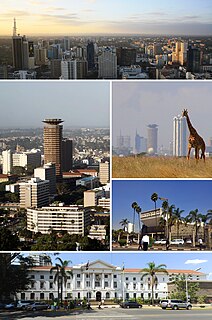
The Kiambere Hydroelectric Power Station is an earth-filled embankment dam on the Tana River near Kiambere, Kenya. It straddles the border of Embu and Kitui Counties in Eastern Province. The primary purpose of the dam is hydroelectric power generation and it supports a 165 MW power station. Construction on the dam began in 1983 and it was completed in 1987. The power station was commissioned in 1988. Beginning in 2008 both turbine-generators were upgraded from 72 MW to 82.5 MW. They were commissioned in 2009. US$95 million in funding for the original project was provided by the World Bank. The power station is operated by Kenya Electricity Generating Company and is part of the Seven Forks Scheme.

The Olkaria I Geothermal Power Station, also known as Olkaria I Geothermal Power Plant is a geothermal power station in Kenya, with an installed capacity of 185 megawatts (248,000 hp).

The Olkaria II Geothermal Power Station also known as Olkaria II Geothermal Power Plant is a geothermal power plant in Kenya, with installed electric generating capacity of 105 megawatts (141,000 hp)

The Karuma Hydroelectric Power Station is a 600 MW hydroelectric power project under construction in Uganda. When completed, it will be the largest power-generating installation in the country.

Magwagwa is a small town in Nyamusi division, Nyamira County in Kenya.

Ngong Hills Wind Power Station, also Ngong Hills Wind Farm, is a wind-powered power station in Kenya.

Rabai Thermal Power Station is a 90 megawatt heavy fuel oil-fired thermal power station in Kilifi County, Kenya.
The Isebania–Kisii–Ahero Road is a road section of the A1 road in Kenya, connecting the towns of Isebania, Migori, Kisii and Ahero.
The Kisumu–Kakamega–Webuye–Kitale Road, is a rural road in Kenya. The road links Kisumu, in Kisumu County, to the towns of Kakamega, in Kakamega County, Webuye in Bungoma County, and Kitale in Trans-Nzoia County.

The Tana Hydroelectric Power Station is a 20 MW (27,000 hp) hydroelectric power station on the Tana River in southern Kenya.

The Wanjii Hydroelectric Power Station is a 7.4 MW (9,900 hp) hydroelectric power station in Kenya.

The Ndula Hydroelectric Power Station is a 2.0 MW (2,700 hp) hydroelectric power station on the Thika River in Kenya.
The Isinya–Singida High Voltage Power Line is a high voltage electricity power line, under construction, connecting the high voltage substation at Isinya, Kenya to another high voltage substation at Singida, Tanzania.

Nkusi Hydroelectric Power Station, also referred to as Nkusi Power Station, is a 9.6 MW (12,900 hp) hydroelectric power station under construction in the Western Region of Uganda.

The Olkaria V Geothermal Power Station, also known as the Olkaria V GeothermakPower Plant is a power station under construction in Kenya, with a planned electric capacity of 140 megawatts (190,000 hp).

Kyambura Hydroelectric Power Station, commonly referred to as Kyambura Power Station, is a 7.6 megawatts (10,200 hp) mini hydropower station under construction in Uganda.









